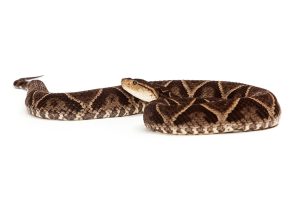Im tiefgrünen Dickicht der südamerikanischen Regenwälder lauert ein Geschöpf, dessen Anwesenheit wohl nur selten mit Freude zur Kenntnis genommen wird: der Bothrops jararacussu, im Deutschen besser bekannt als Jararacussu-Lanzenotter. Diese Schlange gehört zur Familie der Vipern (Viperidae) und ist insbesondere für ihre Giftigkeit bekannt. Die Systematik ordnet sie den Reptilien, genauer den Schuppenkriechtieren (Squamata), zu, wo sie aufgrund der charakteristischen, lanzenförmigen Kopfform und des potenten Giftapparates zu den Grubenottern gezählt wird.
Mit ihrem kräftigen Körperbau und einer beachtlichen Länge von bis zu 1,5 Metern kann man die Jararacussu-Lanzenotter kaum übersehen – sofern sie sich entscheidet, ihre hervorragende Tarnfähigkeit aufzugeben. Die Hautfärbung ist typischerweise ein Muster aus verschiedenen Braun- und Gelbtönen, wodurch sie sich geschickt in ihre Umgebung einfügt und vor Feinden ebenso wie vor potenzieller Beute verborgen bleibt.
Nosologisch bedeutsam ist die Giftigkeit der Jararacussu-Lanzenotter, die mit einem Biss ihre Opfer mit einem hoch toxischen Cocktail attackiert, welcher sowohl hämotoxische als auch nekrotisierende Wirkung hat und somit das Gewebe des Gebissenen schädigt sowie dessen Blutgerinnung beeinträchtigt. Die Schlange ist demnach nicht nur für Beutetiere eine tödliche Gefahr, sondern auch für den Menschen, sollte ein Biss nicht zeitnah medizinisch behandelt werden.
Trotz ihrer Gefährlichkeit ist die Jararacussu-Lanzenotter ein wichtiger Bestandteil des ökologischen Systems ihres Habitats. Sie spielt eine wesentliche Rolle im Gleichgewicht der Nahrungsketten, indem sie die Population von Nagern und anderen Kleintieren reguliert. Diese Schlange, obwohl sie Respekt und Vorsicht gebietet, ist somit ein faszinierendes Beispiel für die Anpassungsfähigkeit und Spezialisierung innerhalb der Reptilienwelt Südamerikas.
Fakten
- Klasse: Actinopterygii (Strahlenflosser)
- Ordnung: Pleuronectiformes (Plattfische)
- Familie: Bothidae
- Gattung: Bothus
- Art: Bothus mancus, deutscher Name: Pfauen-Flunder
- Verbreitung: Indopazifischer Ozean, Rotes Meer, Südliches Afrika bis Hawaii, Marquesas und Tuamotu
- Lebensraum: Korallenriffe, sandige Böden, oft in Lagunen und seichtem Wasser
- Körpergröße: bis zu 45 cm
- Gewicht: Informationen zum Gewicht spezifisch für Bothus mancus sind allgemein nicht verfügbar, aber Plattfische dieser Größe wiegen typischerweise zwischen 0,5 und 2 kg
- Soziales Verhalten: Einzelgänger, verlässt sich auf Tarnung um Beute zu überwältigen und Raubfeinden zu entgehen
- Fortpflanzung: Freiwasserlaicher, Eier und Larven sind pelagisch
- Haltung: in der Aquaristik eher selten, erfordert große Tanks mit Sandboden und guter Wasserqualität
Systematik ab Familie
Description and Behavior
The jararacussu can grow up to 2.2 meters (7.2 feet) in length and has a robust body with a distinctive head shape. Its coloration varies widely, typically featuring a background of brown or yellow with dark patterns that can resemble arches or spots along its back. These markings serve as camouflage in its natural habitat. The snake possesses medium-sized eyes with vertical slit pupils, which enhance its ability to hunt during both day and night.This species is primarily diurnal but can also be active at night. It usually hunts for amphibians and rodents, using its excellent camouflage to ambush prey. The jararacussu is ovoviviparous, giving birth to 16 to 20 young during the rainy season. Its aggressive nature makes it a formidable predator as well as a dangerous encounter for humans.
Geographic Range
The geographic distribution of Bothrops jararacussu includes coastal regions of Brazil from Bahia to Santa Catarina, extending into Paraguay, southeastern Bolivia, and northeastern Argentina. This snake prefers humid environments such as Atlantic forests but can also be found in drier areas like semi-deciduous forests and low swampy regions along riverbanks.The jararacussu’s adaptability to various habitats contributes to its widespread presence in these regions. However, habitat destruction due to urbanization and agricultural expansion poses significant threats to its populations.
Venom Composition
The venom of Bothrops jararacussu is highly toxic and contains a complex mixture of cytotoxins, hemotoxins, and myotoxins. It is potent enough to potentially kill multiple adult humans if left untreated. The venom can cause severe local effects such as necrosis and systemic complications like shock and renal failure following a bite. Studies have shown that bites from larger specimens are particularly dangerous, with severe symptoms reported in victims.The LD50 values indicate the dosage required to kill half of a test population; for jararacussu venom, the values are approximately 0.14 mg/kg for intravenous injection and 4.92 mg/kg for subcutaneous injection. The venom yield can exceed 1000 mg per snake, sufficient to affect numerous small mammals.
Clinical Effects
Victims of Bothrops jararacussu bites may experience dramatic clinical symptoms ranging from local swelling and pain to systemic effects such as coagulopathy and renal failure. In severe cases, fatalities have occurred despite medical intervention with antivenom treatments. Reports indicate that even smaller specimens can cause significant blood incoagulability.The venom’s action is not solely related to direct tissue damage; it also triggers immune responses that exacerbate inflammation and tissue injury. Research has identified various components within the venom that contribute to these toxic effects, highlighting the need for effective antivenom therapies.
Conservation Status
Bothrops jararacussu faces threats primarily from habitat loss due to human activities such as deforestation and land conversion for agriculture. Conservation efforts are essential to protect this species‘ remaining habitats and ensure its survival in the wild.Public awareness campaigns regarding the dangers of snake bites and the ecological importance of pit vipers can help mitigate human-snake conflicts. Additionally, further research into effective antivenoms and treatment protocols for snakebite victims remains critical in reducing mortality rates associated with bites from this species.
Sources
https://www.sciencedirect.com/science/article/pii/S0041010114002244
https://en.wikipedia.org/wiki/Bothrops_jararacussu
https://pubmed.ncbi.nlm.nih.gov/6605493/

